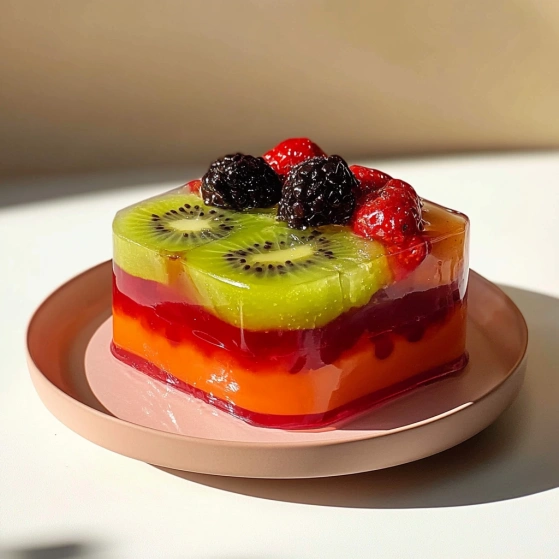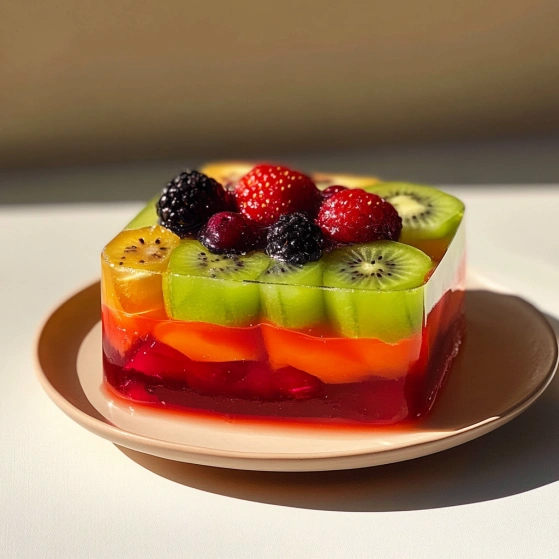 Pin it
Pin it
This beautiful layered fruit jelly transforms ordinary fruit juice into a stunning dessert that will impress family and friends alike. The translucent layers showcase vibrant fresh fruits while creating a light, refreshing treat perfect for warm weather entertaining or a delightful everyday dessert.
I first created this recipe when looking for an elegant but light dessert for a summer garden party. The colorful layers captured the sunlight beautifully and guests were amazed that something so impressive could be made with such simple ingredients.
Ingredients
- Fruit juice blend: Provides the base flavor, choose high quality not from concentrate juices for best taste
- Gelatin powder or agar agar: Creates the perfect wobbly texture while agar agar offers a vegetarian alternative
- Granulated sugar or alternative sweeteners: Let you control the sweetness level
- Fresh fruit (kiwi slices): Creates a stunning visual effect when revealed
- Strawberries and mango: Add bursts of color and flavor throughout the jelly
- Optional natural food coloring: Enhances the visual appeal, especially with clear juices
Step-by-Step Instructions
- Prepare the fruit layer:
- Add fruit juice and gelatin to a medium pot allowing them to sit together for 5 minutes. This blooming process is crucial for smooth texture as it allows the gelatin to hydrate before heating. Heat slowly over medium low while stirring until completely dissolved watching carefully to avoid boiling which can reduce the setting power.
- Add sweetener and color:
- Remove the mixture from heat and stir in your sweetener of choice. If using food coloring incorporate it now starting with just a few drops and adjusting to reach your desired intensity. Allow the mixture to cool slightly but not set before assembling.
- Arrange the fruit:
- While the mixture is still warm but not hot place kiwi slices decoratively on the bottom of your glass dish or mold. Pour just enough warm juice mixture to cover the kiwi completely then distribute strawberry and mango pieces throughout pouring the remaining mixture over top.
- Set the first layer:
- Place the dish in refrigerator for at least 2 hours if using gelatin or let stand at room temperature for 20 30 minutes if using agar agar. The layer must be completely set before adding the next layer to prevent mixing.
- Create the juice layer:
- Repeat the blooming and dissolving process with your second fruit juice and gelatin or agar agar mixture. Allow to cool slightly but remain pourable.
- Add the final layer:
- Pour the juice mixture carefully over the set fruit layer using the back of a spoon to break the fall of the liquid. This prevents the warm liquid from creating holes in your set layer. Return to refrigerator or counter to set completely.
- Unmold and serve:
- Once fully set run a butter knife around the edges of the mold then briefly dip the bottom in warm water to help release. Place a serving plate on top and carefully flip to reveal your beautiful creation.
 Pin it
Pin it
The kiwi arrangement is my favorite part of this recipe. When you flip the mold and reveal the stunning green circles against the colorful jelly it never fails to bring gasps of delight from guests. My daughter now insists on helping arrange the fruit patterns creating her own artistic designs each time.
Creative Variations
This recipe welcomes endless creativity with the juice and fruit combinations. Try using coconut water with tropical fruits for a lighter version or dark grape juice with berries for a more intense flavor profile. For special occasions add a splash of sparkling wine to the juice mixture before setting. Match your fruit choices to complement the juice flavors like using peach juice with sliced peaches and raspberries or apple juice with thinly sliced apples and blueberries.
Troubleshooting Tips
If your jelly fails to set properly you may need more gelatin or agar agar especially when using juices with high acidity like pineapple. Some fresh fruits like pineapple kiwi and papaya contain enzymes that can prevent gelatin from setting properly. Using canned versions or briefly cooking these fruits beforehand deactivates the enzymes. For clearer jellies strain your juice before using and avoid boiling the gelatin mixture which can create cloudiness.
Serving Suggestions
Present your layered fruit jelly as the centerpiece of a dessert table accompanied by a light whipped cream or coconut cream topping. For a more substantial dessert plate each slice with fresh berries and a small scoop of vanilla ice cream. This jelly also makes a refreshing breakfast or brunch option when served alongside yogurt and granola. For children's parties use fun shaped molds and pair with colorful fruit skewers for an eye catching treat.
 Pin it
Pin it
Frequently Asked Questions
- → Can I use different fruits in this jelly?
Absolutely! While the original uses kiwi, strawberries and mango, you can substitute with fruits like blueberries, peaches, raspberries or pineapple. Just avoid using fresh pineapple, kiwi, papaya, or figs in gelatin (not agar-agar) as their enzymes prevent setting. Canned versions work fine with gelatin.
- → What's the difference between using gelatin and agar-agar?
Gelatin is animal-derived and creates a soft, wobbly texture that melts at body temperature. Agar-agar is plant-based (from seaweed), sets more firmly at room temperature, and doesn't melt until higher temperatures. Agar-agar makes the dessert vegetarian/vegan-friendly and stable at warm temperatures.
- → Why is my jelly cloudy instead of clear?
Cloudiness can occur if the gelatin or agar-agar is boiled too vigorously, if there are impurities in your juice, or if the mixture was stirred too much while setting. For clearer jellies, heat gently, use filtered juice, and avoid disturbing the mixture while it sets.
- → Can I make this dessert ahead of time?
Yes! This dessert is perfect for preparing 1-2 days ahead. Keep it covered in the refrigerator until ready to serve. However, for best appearance, unmold just before serving as condensation can form on the surface if unmolded too early.
- → Why did my second layer crack my first layer?
If your second layer mixture is too hot when poured onto the set first layer, it can melt or crack it. Always let the second layer mixture cool slightly (but not set) and pour it over the back of a spoon to disperse the liquid gently across the surface of the first layer.
- → What juices work best for this dessert?
Clear fruit juices like apple, white grape, or lychee work beautifully for transparent layers. For colored layers, try cranberry, strawberry, or tropical blends. Avoid thick juices like orange with pulp unless strained, as they can create a cloudy appearance.
